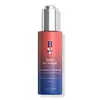What's inside
What's inside
 Key Ingredients
Key Ingredients

 Benefits
Benefits

 Concerns
Concerns

 Ingredients Side-by-side
Ingredients Side-by-side

Water
Skin ConditioningGlycerin
HumectantPolysorbate 20
EmulsifyingGlycyrrhiza Glabra Root Extract
BleachingSaccharomyces Ferment Lysate Filtrate
Skin ConditioningGlycine
BufferingPisum Sativum Extract
Skin ConditioningPullulan
Zinc Sulfate
AntimicrobialQuercus Robur Bark Extract
AstringentLarix Europaea Wood Extract
HumectantZinc Gluconate
Skin ConditioningAcetyl Tyrosine
Skin ConditioningAmaranthus Caudatus Seed Extract
Skin ConditioningUrtica Dioica Leaf Extract
Skin ConditioningHydrolyzed Yeast Protein
Skin ConditioningCamellia Sinensis Leaf Extract
AntimicrobialVitis Vinifera Seed Extract
AntimicrobialZinc Chloride
AntimicrobialHydroxyethylcellulose
Emulsion StabilisingLysolecithin
EmulsifyingXanthan Gum
EmulsifyingSclerotium Gum
Emulsion StabilisingParfum
MaskingSodium Hydroxide
BufferingPentylene Glycol
Skin ConditioningHydroxyacetophenone
AntioxidantLimonene
PerfumingLinalool
PerfumingWater, Glycerin, Polysorbate 20, Glycyrrhiza Glabra Root Extract, Saccharomyces Ferment Lysate Filtrate, Glycine, Pisum Sativum Extract, Pullulan, Zinc Sulfate, Quercus Robur Bark Extract, Larix Europaea Wood Extract, Zinc Gluconate, Acetyl Tyrosine, Amaranthus Caudatus Seed Extract, Urtica Dioica Leaf Extract, Hydrolyzed Yeast Protein, Camellia Sinensis Leaf Extract, Vitis Vinifera Seed Extract, Zinc Chloride, Hydroxyethylcellulose, Lysolecithin, Xanthan Gum, Sclerotium Gum, Parfum, Sodium Hydroxide, Pentylene Glycol, Hydroxyacetophenone, Limonene, Linalool
Water
Skin ConditioningButylene Glycol
HumectantPPG-26-Buteth-26
Skin ConditioningPEG-40 Hydrogenated Castor Oil
EmulsifyingApigenin
AntioxidantOleanolic Acid
Skin ConditioningBiotinoyl Tripeptide-1
Quercus Serrata Extract
Skin ConditioningRosmarinus Officinalis Extract
AntimicrobialHydroxyethylcellulose
Emulsion StabilisingSophora Japonica Extract
EmollientNiacinamide
SmoothingAscorbic Acid
AntioxidantBisabolol
MaskingBiotin
AntiseborrhoeicHydrolyzed Rice Protein
Skin ConditioningTocopheryl Acetate
AntioxidantSodium PCA
HumectantPolysorbate 20
EmulsifyingCitrus Aurantium Dulcis Oil
MaskingVinegar
Dicalcium Phosphate
AbrasiveXanthan Gum
EmulsifyingPhenoxyethanol
PreservativeEthylhexylglycerin
Skin ConditioningLimonene
PerfumingWater, Butylene Glycol, PPG-26-Buteth-26, PEG-40 Hydrogenated Castor Oil, Apigenin, Oleanolic Acid, Biotinoyl Tripeptide-1, Quercus Serrata Extract, Rosmarinus Officinalis Extract, Hydroxyethylcellulose, Sophora Japonica Extract, Niacinamide, Ascorbic Acid, Bisabolol, Biotin, Hydrolyzed Rice Protein, Tocopheryl Acetate, Sodium PCA, Polysorbate 20, Citrus Aurantium Dulcis Oil, Vinegar, Dicalcium Phosphate, Xanthan Gum, Phenoxyethanol, Ethylhexylglycerin, Limonene
Ingredients Explained
These ingredients are found in both products.
Ingredients higher up in an ingredient list are typically present in a larger amount.
Hydroxyethylcellulose is used to improve the texture of products. It is created from a chemical reaction involving ethylene oxide and alkali-cellulose. Cellulose is a sugar found in plant cell walls and help give plants structure.
This ingredient helps stabilize products by preventing ingredients from separating. It can also help thicken the texture of a product.
This ingredient can also be found in pill medicines to help our bodies digest other ingredients.
Learn more about HydroxyethylcelluloseLimonene is a fragrance that adds scent and taste to a formulation.
It's found in the peel oil of citrus fruits and other plants such as lavender and eucalyptus. The scent of limonene is generally described as "sweet citrus".
Limonene acts as an antioxidant, meaning it helps neutralize free radicals.
When exposed to air, oxidized limonene may sensitize the skin. Because of this, limonene is often avoided by people with sensitive skin.
The term 'fragrance' is not regulated in many countries. In many cases, it is up to the brand to define this term. For instance, many brands choose to label themselves as "fragrance-free" because they are not using synthetic fragrances. However, their products may still contain ingredients such as essential oils that are considered a fragrance.
Learn more about LimonenePolysorbate 20 is made by combining ethoxylation of sorbitan, ethylene oxide, and lauric acid. It is a mild cleansing agent, surfactant, and emulsifier.
As a surfactant, it helps collect dirt and oils for washing. Emulsifiers prevent oils and water from separating.
Polysorbate 20 also adds scent to a product. Since it is made using sorbitol, it has a sweet scent. Sorbitol can also be found in fruits such as apples and peaches.
The lauric acid used to create Polysorbate 20 is often derived from coconuts.
Polysorbate 20 may not be fungal acne safe.
Learn more about Polysorbate 20Water. It's the most common cosmetic ingredient of all. You'll usually see it at the top of ingredient lists, meaning that it makes up the largest part of the product.
So why is it so popular? Water most often acts as a solvent - this means that it helps dissolve other ingredients into the formulation.
You'll also recognize water as that liquid we all need to stay alive. If you see this, drink a glass of water. Stay hydrated!
Learn more about WaterXanthan gum is used as a stabilizer and thickener within cosmetic products. It helps give products a sticky, thick feeling - preventing them from being too runny.
On the technical side of things, xanthan gum is a polysaccharide - a combination consisting of multiple sugar molecules bonded together.
Xanthan gum is a pretty common and great ingredient. It is a natural, non-toxic, non-irritating ingredient that is also commonly used in food products.
Learn more about Xanthan Gum